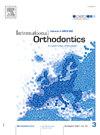Comparison of stress distribution and displacement pattern of maxillary expansion in craniomaxillary complex using rapid maxillary expander and maxillary skeletal expander: A finite element model analysis
IF 1.9
Q2 DENTISTRY, ORAL SURGERY & MEDICINE
引用次数: 0
Abstract
Introduction
A combination of miniscrews and the maxillary skeletal expander (MSE) was created to address potential issues with the traditional rapid maxillary expander (RME). This study was conducted to assess and compare stress distribution and displacement patterns in the craniomaxillary complex during maxillary expansion using Rapid Maxillary Expander (RME) and Maxillary Skeletal Expander (MSE) using 3D Finite Element model.
Methods
A 3D Finite Element model of the craniomaxillary complex, including the maxilla and maxillary dentition, was generated using computer aided design software. Stress distribution and displacement patterns were analysed for both RME and MSE treatments.
Results
The results showed that MSE had greater bone displacement, bone stress, teeth displacement, teeth stress, and periodontal displacement and stress compared to RME. In terms of suture displacement, MSE had higher frontonasal suture displacement compared to RME. Teeth displacement showed that central and lateral incisors showed palatal displacement with RME and buccal displacement with MSE, while canine, premolars, and molars all showed greater buccal displacement with MSE compared to RME along the transverse axis. Central incisor displacement was observed in the extrusion direction with RME, while it was in the intrusion direction with MSE. In terms of teeth stress, MSE treatment resulted in higher stress on the central incisor, lateral incisor, canine, premolars, and molars compared to RME treatment.
Discussion
Overall, MSE exhibited greater bone displacement, stress, and suture displacement/stress compared to RME. Additionally, MSE induced different tooth displacement patterns with higher stress on teeth compared to RME. These findings suggest differences in treatment outcomes and biomechanical effects between the two expansion methods.
上颌快速扩张器与上颌骨扩张器在颅颌复合体中上颌扩张应力分布及位移模式的比较:有限元模型分析
为了解决传统快速上颌扩张器(RME)存在的潜在问题,提出了一种微型支架与上颌骨骼扩张器(MSE)的组合。本研究采用三维有限元模型评估和比较快速上颌扩张器(RME)和上颌骨骼扩张器(MSE)在上颌扩张过程中颅颌复合体的应力分布和位移模式。方法利用计算机辅助设计软件建立包括上颌和上牙列在内的颅颌复合体三维有限元模型。分析了RME和MSE处理的应力分布和位移模式。结果MSE组骨位移、骨应力、牙位移、牙应力、牙周位移和牙周应力均大于RME组。在缝线位移方面,MSE比RME有更高的额鼻缝线位移。牙齿位移显示中切牙和侧切牙的颊部位移和颊部位移均以RME为主,而犬齿、前磨牙和磨牙的颊部位移均以MSE为主。用RME观察中切牙在挤压方向位移,用MSE观察中切牙在侵入方向位移。在牙齿应力方面,与RME治疗相比,MSE治疗导致中切牙、侧切牙、犬齿、前磨牙和磨牙的应力更高。总的来说,与RME相比,MSE表现出更大的骨位移、应力和缝线位移/应力。此外,与RME相比,MSE诱导的牙齿位移模式不同,对牙齿的应力更高。这些发现表明两种扩张方法在治疗结果和生物力学效应上存在差异。
本文章由计算机程序翻译,如有差异,请以英文原文为准。
求助全文
约1分钟内获得全文
求助全文
来源期刊

International Orthodontics
DENTISTRY, ORAL SURGERY & MEDICINE-
CiteScore
2.50
自引率
13.30%
发文量
71
审稿时长
26 days
期刊介绍:
Une revue de référence dans le domaine de orthodontie et des disciplines frontières Your reference in dentofacial orthopedics International Orthodontics adresse aux orthodontistes, aux dentistes, aux stomatologistes, aux chirurgiens maxillo-faciaux et aux plasticiens de la face, ainsi quà leurs assistant(e)s. International Orthodontics is addressed to orthodontists, dentists, stomatologists, maxillofacial surgeons and facial plastic surgeons, as well as their assistants.
 求助内容:
求助内容: 应助结果提醒方式:
应助结果提醒方式:


